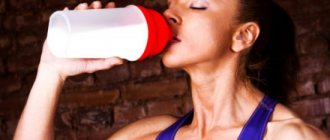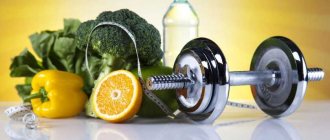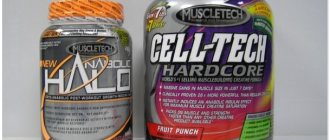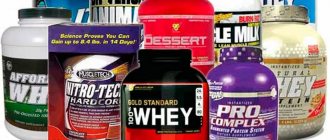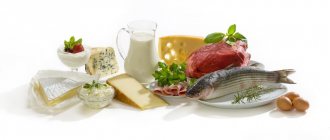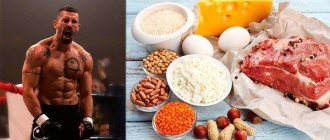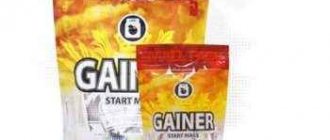Post-workout nutrition is critical for muscle recovery and replenishment of lost fluids. And the most widely known method is taking whey protein. Since it is a “fast” protein, it is natural to want to replenish protein in the muscles, the faster the better. What is important for the subsequent growth of muscle fibers. The majority thinks so. Everything is logical and correct...
Or is this a marketing ploy by sports nutrition companies? But how did athletes used to drink milk to gain muscle mass and strength... And the results seemed to be decent... Or is it impossible to do without sports supplements in our time?
Composition of milk
1 cup (250 ml) of whole milk contains 8 grams of protein, 13 grams of carbohydrates, 8 grams of fat and 150 calories. As well as 290 mg of calcium and 107 mg of sodium. This combination makes it an ideal product for muscle gain and recovery. Full composition:
Casein
Slowly digesting protein. Milk consists of 80% casein - a milk protein that maintains a feeling of fullness longer, helps get rid of excess fat in the body and restore muscle tissue.
Serum
Fast digesting protein. Milk consists of 20% whey protein, the same protein found in protein shakes to quickly saturate muscles.
BCAAs
Dairy products are rich in branched chain amino acids: leucine, isoleucine, valine. A protein-rich dairy diet contains sufficient BCAAs. There is no need to spend money on supplements.{banner_st-d-2}
Carbohydrates
Our body uses the lactose contained in milk to replenish energy reserves. Although some people are not able to digest it. Therefore, it is recommended to take lactase tablets (Lactazar) if you experience bloating and loose stools after eating dairy products. In turn, consuming lactose-free milk is more convenient, but much more expensive.
Fats
Fat content is 1-3 grams per 100 ml, unless of course you consume skim milk. They are digested slowly and maintain a feeling of fullness for a long time, reducing the feeling of hunger.
Calcium
Milk calcium accelerates the fat burning process and promotes bone health. The latter is especially important for the fair half of humanity (osteoporosis).
Water
Milk contains about 87% water. Adequate hydration improves muscle recovery and can increase strength by preventing fatigue and stagnation.
Electrolytes
Sodium and potassium contribute to better replenishment of lost fluid in the post-training period by retaining water in the body's cells.
Nutrients
Biotin, magnesium, vitamin A, vitamin B 12, vitamin D, vitamin K, riboflavin and many others. 5 Reasons Why You Should Drink Milk After a Workout
Contraindications and harms of milk
The main danger of cow's milk is its high allergenicity. Casein protein provokes a violent reaction in the body: if the product is poorly digested, for various reasons, it enters the bloodstream. And already here antigens attack him, trying to destroy the pathogen of calm.
The more often the collision occurs, the more pronounced the allergic reaction. Most often it is expressed by a small rash and itchy skin. As a result, the body generally stops accepting all dairy products. And if you continue to persist, it is possible that you will develop type I diabetes.
Another danger of milk is lactose or milk sugar. His intolerance or scientifically lactose deficiency is a common occurrence. And you can suspect something is wrong by the diarrhea that always occurs in response to a glass of milk. In this case, you shouldn’t persist either, because lactose intolerance is not at all as harmless as is commonly believed. She can:
- provoke the development of cellulite;
- lead to arthritis;
- start the process of clouding the lens of the eye (cataract).
Lactose-free milk has long been common. Yes, it is more expensive than natural. But it is absolutely safe for people with severe lactose intolerance.
Interestingly, cow's milk appeared in the human diet about 10 thousand years ago. And at first it was consumed only by young children, who in the first years of life produced an enzyme capable of breaking down lactose. Over time, as a result of gene mutations, this ability began to persist into adulthood. Today in the world, 50% of adults can drink milk without unpleasant consequences. Moreover, the majority of them are residents of the European continent, the minority are Asians, Africans and Australians.
But those athletes who have ever been diagnosed with kidney disease need to be the most careful. In some cases, drinking milk is strictly prohibited. And to answer the question whether or not you can diversify your diet, in this case only a doctor can.
The benefits of milk for gaining muscle mass
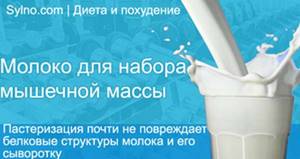
Muscle growth. Numerous studies suggest that a mixture of slow and fast digesting proteins is the best nutritional option for gaining lean muscle mass. Milk is 80% casein and 20% whey. Fat loss. Calcium accelerates the burning of excess weight, and milk fat maintains a feeling of fullness and promotes the loss of fat deposits in the body. Recovery. Milk is a liquid containing electrolytes. And it replenishes fluid lost during training more effectively than water. Price. Considering the proteins (casein, whey, BCAAs) and the energy composition of the product, this is one of the cheapest and most accessible types of nutrition. Simplicity. It doesn't need to be cooked. 1 liter of milk can be an ideal post-workout meal, depending on your daily calorie needs.
Comparison with serum
Many people believe that they need serum after a workout. Maybe because the manufacturing companies insist on it. But most studies show that it is “slow” or a mixture of “slow” and “fast” protein that is most effective for gaining lean muscle mass.
Whey is a “fast” protein. While milk is a mixture of slow and fast digesting proteins, it is therefore more effective than whey and soy milk, which contain only “fast” proteins. Meat, poultry or fish are also more effective than whey. It's not surprising that many people successfully eat nutritious meals after workouts.
Comparison with sports drinks
Strength training leads to water loss through sweating. Signs of dehydration are very unpleasant and similar to a hangover: headache and fatigue. Replenishing lost fluid is key to muscle recovery. Milk is superior to sports drinks due to its higher sodium and potassium content, which retain water. In addition, sports drinks contain a lot of carbohydrates, which can lead to the accumulation of fatty tissue. They are more effective for athletes who train for endurance.{banner_st-d-1}
Comparison with skim milk
The fat in whole milk makes it taste better and keeps you feeling full longer. This way, you eat less and feel less hungry. They also slow down the absorption of the product. Although, naturally, the presence of fat in whole milk significantly increases its total calorie content.
Calculation per 1 liter.
Whole milk: 30 g protein, 40 g carbohydrates, 35 g fat, 600 kcal. 1% fat: 30 g protein, 40 g carbohydrates, 10 g fat, 370 kcal.
Low fat: 30 g protein, 40 g carbohydrates, 0 g fat, 280 kcal.
In what form is it better to drink?
So, you decided to drink milk before running or after strength training, now you just need to decide in what form it is best to consume it:
- The most useful thing is whole, paired. But it must be boiled, since it may contain pathogenic microorganisms. Drink this milk without boiling, only from your own cow;
- Sterilized, pasteurized or normalized product is now widely available in grocery stores. You can drink it without additional processing, just watch the fat content and expiration date;
- It is not recommended to drink reconstituted or recombined milk - it contains too few natural ingredients. Essentially, these are powders diluted with water, which can only be considered dairy products;
- If you have lactose deficiency, you can use a high-quality lactose-free product;
- There is a similar requirement for powdered milk - there should be nothing unnecessary in the composition. The mixture will not be cheap, but it will be in no way inferior to the usual format in terms of benefits.
Whole milk powder is especially useful for men after training - it should be diluted with warm boiled water, add oatmeal and fresh berries. The result is an explosive cocktail for the growth of beautiful muscle relief.
Cow's milk can be replaced with vegetable milk - sesame, soy, coconut, pumpkin.
If desired, you can make different cocktails from the drink, for example, a mixture of cow's milk, nuts, strawberries and banana is very tasty. You can also mix the product with natural yogurt, honey and fresh berries. If you want to make a particularly nutritious mixture, add flakes and bran to the milk base with honey.
Recommendations for burning fat
To lose weight, we need to eat fewer calories or burn more. Dairy fat will not make us fat. And in general, we won’t get fat from any food if we have a calorie deficit. Just like any food, including protein, can lead to the accumulation of fat mass if there is an excess of calories. In other words: it is not fat that makes us fat, but excess calories. In a general calorie deficit, it doesn't matter whether you drink whole or skim milk.
Thus, what kind of milk you will drink in the post-training period depends entirely on the energy needs of the body, that is, it mainly depends on your weight. For example, if you weigh 80 kg, then you need not to exceed 2400 kcal per day in order to lose weight. A liter of milk after your workout will mean you have 1800 kcal left over for the rest of the day. If your weight is about 100 kg, then to lose fat you should not exceed 3000 kilocalories during the day. In this case, 1 liter will mean that you have another 2400 kcal left for the rest of the day.
In other words, if you are trying to lose weight you have two options:
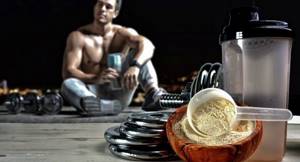
Drink smaller amounts of whole milk: one mug contains 150 kilocalories, and two mugs contain 300 kilocalories. Drinking milk with 1% fat content - one liter contains 370 kilocalories, and two mugs - 185 kilocalories. It all depends on your energy needs for weight loss. And 1% fat is preferable to low fat because the difference in calories is negligible. 1% fat milk contains only 90 kcal more per liter than skim milk and only 45 kcal more if you drink two cups. Insignificant difference.
We need a calorie surplus: eat more or burn less. Therefore, it is quite reasonable to drink 1 liter of whole milk in the post-training period to replenish the energy expended. The most extreme form is the GOMAD technique, popular in the West. Which translates in two ways:
"Go crazy." In fact, there is no need to translate anything, this is an abbreviation: Gallon Of Milk A Day - “Gallon Of Milk A Day”.
An American gallon is equal to 3.78 liters (about 4 litres). Relatively cheap and effective (in 1 gallon you get 2400 kcal and 120 grams of protein) method. Naturally, no one advises drinking a gallon a day right away. Starting from 1 liter per day, gradually increase the amount over the course of a month until you reach 3.78 liters. Your body will adapt smoothly. This is perhaps one of the most effective natural methods of gaining muscle mass for thin young people.
Why drink milk after training?
The key to excellent physical fitness and health lies not only in regular visits to the gym, but also in providing the body with a complex of useful substances.
The main sources of essential proteins, fats and amino acids that “build” muscles are lean meat (chicken, beef), some fish and dairy products, in particular milk.
Its main ability, in addition to restoring water balance (80% of this product consists of water), is saturation with protein.

All food consumed during this period will be used to strengthen the mass, and not a drop of the consumed substance will go into fat. The law of building mass is very simple: in order to saturate your muscles with protein, you need to eat as much protein as possible 15–20 minutes after training, and milk is one of the faithful assistants in this matter.
Of course, this product is not the only source of protein, which is especially effective during the “anabolic window” period, however, for those who strive not only to build muscle, but also to reduce body fat, this dairy product will come in handy.
It is this that gives a quick feeling of fullness, while its active components help reduce the fat network in the tissues.

Another unconditional benefit of this product after physical activity is calcium saturation - tired, overworked joints especially need such calcium “feeding” after a grueling workout.
GOMAD method
What to do: GOMAD won't work if you drink 1 gallon of milk 3 days a week instead of 7, don't exercise enough, and don't eat enough. You need to be consistent!
- 4 liters of whole milk per day. Distribute evenly throughout the day. For example: ¼ for breakfast, ¼ for lunch, ¼ after training, ¼ for dinner.
- Eating every 3 hours. Don't feel hungry: eat until you feel full.
- Training program. Multi-joint compound exercises are a powerful stimulus for muscle growth.
- Count your calories for the day. For best results, it's best to aim for 5,000 calories per day.
- Monitor your progress. Take photos from the front, side and back. Weigh yourself every 2 weeks. Keep a training diary.
- Stop GOMAD when you have achieved the intended result. This should not take more than 1-2 months if you continuously follow this technique.
- Don't stop strength training and keep counting calories so you don't lose the progress you've made.
Is milk good for you after a workout?
Milk is one of the most popular natural drinks around the world.
Even a child knows about the presence of calcium in its composition and the benefits it has on the body, but despite this, it is milk that has been the subject of controversy and disagreement in the food industry over the past 50 years - some researchers claim that this natural product can cause harm to the body ( especially if it is not pasteurized milk), others dispute this point of view.
There are also disagreements among nutritionists who argue whether such a product can be consumed before or after training and whether it is necessary to drink cocktails based on this product to intensify the weight loss process. Let's look at these questions in more detail.
Milk in the diet of an ectomorph
For an ectomorph (hard gainer) who cannot achieve the desired weight, milk may well be the key to achieving results. This is a well-tested method that relies on including milk in your diet. And turning it on in a big way!
Allows you to achieve truly decent results in a fairly short time. Naturally, you achieve the effect only in combination with a healthy diet and hard work in the gym. And maybe even with the addition of sports supplements such as creatine.
To stimulate muscle growth, it is important to aim for 2 grams of protein per 1 kg of body weight per day. From a financial point of view, as well as physiologically, this can be quite difficult for some. Especially for those who, no matter how hard they try, simply cannot eat enough food to achieve a high daily calorie count.
After all, if gaining muscle mass was a piece of cake, you wouldn't be reading this article. If you want to get bigger, then you should consume the same number of calories that the average person consumes at the weight you want to achieve.
For example, if you want to weigh 90 kg, then the average 90 kg person should consume 2700 kcal per day. Let's say this is your goal, but you feel full during the day and can only handle 1700-2000 kcal. Many people face this problem. You count calories (which is critical!) and decide that you need to drink what you can't eat. Approximately 950 additional calories. It is easy to calculate that this is approximately equal to one and a half liters of whole milk or 6 glasses of milk. Quite an achievable goal!
You continue to eat as much as you can at each meal. And when you can no longer eat, milk comes into play, since most people can drink even after the onset of a feeling of satiety and fullness. To supplement the total calorie content, you can drink milk with every meal, and quite often, when there is no time to eat, you can resort to it to quickly nourish the body and not lead to hunger.
What can replace milk?
For those who cannot imagine their life without a glass of milk, but suffer from lactose intolerance, the best option would be to drink powdered or lactose-free milk. It’s more difficult if just the sight of a snow-white drink makes you want to grimace. But, even understanding its benefits, you don’t need to step on your own throat: white cheeses and cottage cheese contain just as much calcium.
And if we are talking about a drinking product, you can replace milk with kefir, fermented baked milk or yogurt. Moreover, fermented milk products are absorbed by the body much better: 91% to 32% of the digestibility of whole milk! At the same time, kefir and yogurt are lower in calories and contain a huge amount of living bacteria that form human immunity.
Vegan and vegetarian athletes can replace cow's milk with plant-based milk. Its beneficial properties directly depend on the original ingredient. Thus, sesame is not inferior to cow's in calcium content, soy is rich in protein and amino acids, coconut contains a large amount of vitamins C and group B, and pumpkin is a record holder for iron and zinc content.
Drinking milk before bed
Another milk strategy is to drink it shortly before going to bed. This way, you will have a source of protein throughout the night beyond what you ate before going to bed. Eating before bed is crucial, whether you're an ectomorph (hard gainer) or not. During sleep (preferably 8 hours!) you will not have the opportunity to eat to help muscle fibers recover after training. If you manage to sleep the much-needed 8 hours, then it would be highly undesirable to spend so much time without food. As an ectomorph or hard gainer, you wouldn't want your body to starve for protein. It should be like a machine, running on protein, like fuel. And as we have already found out, to gain muscle mass, milk contains casein, which is slowly absorbed and therefore is absorbed by the body for a long time and nourishes the muscles for a long time.
When is the best time to drink?
So, should you drink milk before or after training? Start from your goals - if you need to replenish your body with energy, drink a glass an hour before class. If you are trying to replenish the protein supply lost during training in order to stimulate the growth of muscle fibers, drink the drink within an hour after.
In fact, milk is an excellent natural gainer, especially if you add chopped banana and honey. If your goal is muscle growth, you can drink the product throughout the day. The permissible volume during the period of weight gain is about 2 liters! By the way, the drink must be consumed warm.
By the way, if you decide to diversify your diet with fruits, please note that they also have their own consumption rules. For example, do you know when is the best time to eat a banana: before or after a workout?
But if you are wondering whether you can drink milk directly during training, we will answer categorically - no! It is not suitable as an isotonic - it is too heavy. Gainers are drunk strictly after exercise. Protein shakes are also often included in the schedule after exercise. Sometimes before, but never during.
Remember, during strength training you can drink water, isotonics, herbal infusions, fresh juices and amino acid complexes - only they do not interfere with the process and prevent dehydration.
Milk cannot be classified into any of the above groups.
Cottage cheese: attention to composition
Cottage cheese contains many useful substances, which is why it is recommended for everyone who engages in fitness in their free time.
- Casein or slow milk protein. There is almost 60% of it in cottage cheese. Thanks to this element, the energy intensity of a dish with cottage cheese is so high - up to 5 hours.
- Slow carbohydrates, healthy fats - they increase the feeling of fullness.
- Methionine is an amino acid that protects against increased cholesterol levels and fatty liver.
After a workout, you can eat cottage cheese, but not immediately (otherwise you will feel sick), if you want to lose weight, but after about an hour.
And the hour that you wait will be spent replenishing the body’s energy from your own fat deposits.
Plus, you won’t want to eat for a long time, so if you exercised after work, then you won’t eat at night if 60 minutes after exercise you dine with half a pack of cottage cheese, that is, you eat about 100 grams.
But let's continue talking about the composition.
Cottage cheese is also valued due to the fact that it contains phosphorus, calcium, potassium, iron, zinc, sodium, as well as vitamins
A , C , PP .
In this regard, low-fat cottage cheese after a workout or at any other time of the day will not bring much benefit. After all, fats play an important role in the absorption of all these useful elements.

In general, one important fact needs to be taken into account: cottage cheese after a workout is best suited if the goal of these exercises was to gain weight
. After all, this product contains a lot of proteins and carbohydrates - the best “building material” for muscle mass, namely muscle mass, not fat.
How much cottage cheese to eat after a workout depends on many factors. From what time it was, what your body weight is, how you absorb this product and many others. On average, you need to eat from
100 to 180 grams
, but no more.
Especially if it is a meal at night.
By the way, you can eat at night, contrary to popular belief. But only if you are under intense stress.
In general, cottage cheese is good to eat before exercise, but not immediately before exercise.
Is it possible to drink milk before training?
You can drink milk before training, but there are some nuances:
- if you are going to engage in intense exercise at high speed (aerobics, crossfit, etc.), then it is better not to use this product: saturated with protein and carbohydrates, it will take a long time to digest, and during exercise the body will be focused not on working out muscles, but to digest milk components;
- drinking milk immediately before training will contribute to the appearance of heaviness in the stomach;
- those who are lactose intolerant should completely forget about consuming any dairy products (in this case, special lactose-free protein powder mixtures will help).
It is best to consume milk if you are doing strength training for specific muscle groups: in this case, a glass of this product, drunk at least 40 minutes before the start of the workout, will just give strength and energy, and saturate the muscles with the necessary protein. In all other cases, it is better to prefer pure water or a wheat protein shake.
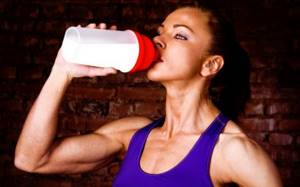
Thus, milk drunk 15 minutes after strength training has undeniable benefits for the body: it saturates muscles with protein, helps eliminate fat, gives a feeling of satiety and restores strength.
As for consuming this product before training, it is necessary to take into account the type of upcoming exercise, the intensity and duration of the workout, and even the amount of water drunk between exercises.
Of course, it is still better to consume any dairy products after a workout, when the muscles have already worked and are ready to receive a dose of protein and protein.

